|
Lost
Buildings |
|
The north boundary of the campus, along Richards
Street, was the site of some of the earliest residential development directly related to
the presence of the college. During the college’s first half-century, students
boarded wherever they could with private landlords or faculty members. With the erection
of the college building in Sherman, several enterprising individuals built boarding houses
near the campus with the intention of cashing in on the need for housing for out-of-town
students.
|
|
 |
Eagleton House, home of
English professor Davis Foute Eagleton and his family, was located at the corner of
Richards and Hurt Streets, facing Hurt. After about 1909, the address was 1024 Hurt,
presently the site of a parking lot serving Cern, Dean Hall, and Abell Library. The
Eagletons provided room and board to a student from time to time. After the college acquired Eagleton House, it served as a dormitory, a center
for foreign students, and a guest lodge. It remained a campus landmark well into the late
1970s. |
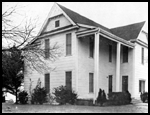 |
|
|
|
|
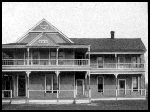 |
|
Hardy House, named for the college clerk during the
1890s, John Hardy, was also located at the northeast corner of Richards and Hurt. The
address was 1405 Richards Street. Hardy and his wife were popular with the students, and a
number of them boarded with the couple. |
|
|
|
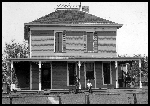 |
|
Bailey House, another boarding house on Richards
Street, provided rooms for students at least until Luckett dormitory was built in 1908 and
possibly after. It burned in 1922. |
|
|
|
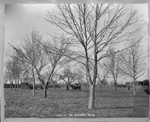 |
|
In 1902, Dr. S. M. Luckett, a
former president of the College, donated a six acre park to be used as an athletic field
located northwest of the old main college building. |
|
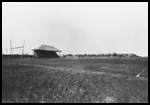 Within two more years, a grand stand was erected on the site with
lumber donated by J. Lewis Thompson. Luckett Field was located at the north end of Luckett
on the site of the Sherman Boy’s Club, the college having donated the property to
that organization. Twenty years later when Cashion field was constructed, the grandstand
structure was moved a short distance to the southwest corner of Grand Avenue and Lewis
Street and remodeled into an apartment house. It burned to the ground in January 1998. Within two more years, a grand stand was erected on the site with
lumber donated by J. Lewis Thompson. Luckett Field was located at the north end of Luckett
on the site of the Sherman Boy’s Club, the college having donated the property to
that organization. Twenty years later when Cashion field was constructed, the grandstand
structure was moved a short distance to the southwest corner of Grand Avenue and Lewis
Street and remodeled into an apartment house. It burned to the ground in January 1998. |
|
|
|
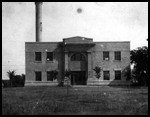 The building now known as Cern, located
on the south side of Richards Street, was built in 1914 at a cost of $15,000 and was
dedicated in April, 1915. The original structure had floor space of about 7,500 square
feet in two floors and a basement. Constructed to house a power plant for the campus, it
contained a two-story boiler room, a fuel room, a room for the electrical power plant, a
room for a pumping station and a large room for a shop. The third floor contained three
rooms specifically designed for the anticipated department of electrical engineering, the
establishment of which was imminently expected at the time of the building’s
construction. The smokestack and third floor were never used for their original purposes,
but that smokestack became a symbol of student pride, adventure, and ritual. Year after
year students scaled it to paint their class year on it. The building now known as Cern, located
on the south side of Richards Street, was built in 1914 at a cost of $15,000 and was
dedicated in April, 1915. The original structure had floor space of about 7,500 square
feet in two floors and a basement. Constructed to house a power plant for the campus, it
contained a two-story boiler room, a fuel room, a room for the electrical power plant, a
room for a pumping station and a large room for a shop. The third floor contained three
rooms specifically designed for the anticipated department of electrical engineering, the
establishment of which was imminently expected at the time of the building’s
construction. The smokestack and third floor were never used for their original purposes,
but that smokestack became a symbol of student pride, adventure, and ritual. Year after
year students scaled it to paint their class year on it. |
|
|
|
 |
Just east of the powerhouse stood
the YMCA building, north of the old main building and just west of Luckett Hall on the
site now occupied by Dean Hall. Cornerstone for the "Y" building was laid on the
same day as the cornerstone for Luckett Hall, May 28, 1907. The "Y" took longer
to build, for it depended in part on student labor and student solicitation of funds. It
was ready for occupancy in 1911 and included a gymnasium, swimming pool, bowling
alley, several meeting rooms, and facilities for campus organizations such as yearbook and
newspaper staffs. During its existence it provided dormitory rooms, faculty offices, a
geology museum, and an arena theatre, built over the swimming pool and bowling alley after
World War II. In 1964, the Y was torn down to make room for a new dormitory. |
 |
 |
|
|
|
|
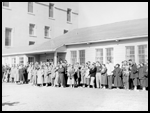 |
|
Adjacent to the YMCA on the east was the frame building
known as the Annex. In the 1930s and ‘40s the Annex served as the student union until
the Memorial Student Union Buildings was completed in 1952. Subsequently the newly created
Home Economics Department occupied the Annex until both it and the YMCA building were
demolished. |
|
 |
  main page | map main page | map |